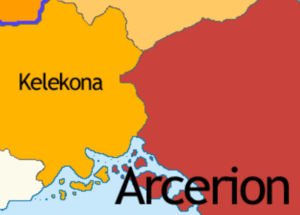Telekonese Conflict: Difference between revisions
mNo edit summary |
mNo edit summary |
||
| Line 39: | Line 39: | ||
| campaignbox = | | campaignbox = | ||
}} | }} | ||
The '''Telekonese Conflict''' is an ethnic and territorial conflict between Arcerion and Kelekona over the disputed region of the Innis River Basin and the Dabhóg Wetlands, inhabited by a mixture of different cultural and ethnic groups, but predominantly naturalized Arcers and Kelekonese indigenous peoples. The region is primarily under the control of Kelekona west of the Innis River, but the Telekonese peoples that make up the Southeastern portion of Kelekona are considered a ''de facto'' nation and have a diaspora that exists across national boundaries. | |||
The conflicts origins began shortly after the end of the [[Arcer Bush Wars|Fourth Bush War]] and the end of the Kelekonese Civil War, where subversive attempts by Titechaxha and Kelekona to subvert Arcer rule and sovereignty in the Innis River Basin were unsuccessful, as the communist and socialist insurgencies they had sponsored were militarily defeated by the time of the 1975 Gameroun Accords. Repeated calls in the League of Nations and international community by the Kelekonese government to return Telekonese-majority areas of Northwest Arcerion had gone unheeded, and growing frustrations in the Kelekonese government's People's Font's communist leadership meant that their newly acquired sovereignty and power after a devastating civil war was threatened by the existence of Arcer military buildup along the border. | |||
The following series of conflicts were attempts by Kelekona to seize the industrially and economically important Innis River Basin, including the Arcer city of Dunborough, resulting in thousands of military deaths and civilian casualties. This also included the attempts by the Kelekonese government to seize the Foxhey Islands and the disputed areas in the [[Arcerion|Gibson Gap]]. Multiple ceasefires and arimstice agreements have subsequently validated Arcer sovereignty, but continued violations have resulted in the ongoing conflict, which has not seen a major outbreak since 2007's escalation. The 2007 conflict resulted in the destabilization of the Yellow Revolution reforms, and the continued slide of Kelekona into sectarian and ethnic infighting amongst rival warlords. This destabilized state has prevented a resurgence in the conflict, although Kelekonan state media consistently blames Arcer involvement, notably the use of the Office of Public Safety and National Security, for the poor state of modern Kelekonese affairs. | |||
Incidents since 2007 are limited, but with [[Operation Redoubt|Operation REDOUBT]] and the attempt by Arcerion and the Cape to bilaterally stabilize Kelekona, casualties and attacks against Arcerion have continued to decline. | |||
== Background == | == Background == | ||
== Timeline == | == Timeline == | ||
=== 1986 Conflict === | === 1986 Conflict === | ||
=== 1991 Conflict === | === 1991 Conflict === | ||
=== 2007 Conflict === | === 2007 Conflict === | ||
== Fatalities == | == Fatalities == | ||
== Foreign Involvement == | == Foreign Involvement == | ||
== Ceasefire and International Mediation == | == Ceasefire and International Mediation == | ||
[[Category: Arcerion]] | [[Category: Arcerion]] | ||
[[Category: Kelekona]] | [[Category: Kelekona]] | ||
Revision as of 05:13, 1 May 2023
| Telekonese Conflict | |||||||||
|---|---|---|---|---|---|---|---|---|---|
 Arco-Kelekonese Border Region, also known as the Telekonese Lowlands. | |||||||||
| |||||||||
| Belligerents | |||||||||
|
|
| ||||||||
The Telekonese Conflict is an ethnic and territorial conflict between Arcerion and Kelekona over the disputed region of the Innis River Basin and the Dabhóg Wetlands, inhabited by a mixture of different cultural and ethnic groups, but predominantly naturalized Arcers and Kelekonese indigenous peoples. The region is primarily under the control of Kelekona west of the Innis River, but the Telekonese peoples that make up the Southeastern portion of Kelekona are considered a de facto nation and have a diaspora that exists across national boundaries.
The conflicts origins began shortly after the end of the Fourth Bush War and the end of the Kelekonese Civil War, where subversive attempts by Titechaxha and Kelekona to subvert Arcer rule and sovereignty in the Innis River Basin were unsuccessful, as the communist and socialist insurgencies they had sponsored were militarily defeated by the time of the 1975 Gameroun Accords. Repeated calls in the League of Nations and international community by the Kelekonese government to return Telekonese-majority areas of Northwest Arcerion had gone unheeded, and growing frustrations in the Kelekonese government's People's Font's communist leadership meant that their newly acquired sovereignty and power after a devastating civil war was threatened by the existence of Arcer military buildup along the border.
The following series of conflicts were attempts by Kelekona to seize the industrially and economically important Innis River Basin, including the Arcer city of Dunborough, resulting in thousands of military deaths and civilian casualties. This also included the attempts by the Kelekonese government to seize the Foxhey Islands and the disputed areas in the Gibson Gap. Multiple ceasefires and arimstice agreements have subsequently validated Arcer sovereignty, but continued violations have resulted in the ongoing conflict, which has not seen a major outbreak since 2007's escalation. The 2007 conflict resulted in the destabilization of the Yellow Revolution reforms, and the continued slide of Kelekona into sectarian and ethnic infighting amongst rival warlords. This destabilized state has prevented a resurgence in the conflict, although Kelekonan state media consistently blames Arcer involvement, notably the use of the Office of Public Safety and National Security, for the poor state of modern Kelekonese affairs.
Incidents since 2007 are limited, but with Operation REDOUBT and the attempt by Arcerion and the Cape to bilaterally stabilize Kelekona, casualties and attacks against Arcerion have continued to decline.